Lecture 8: Regional Circulations & Circulatory Shock
1/91
There's no tags or description
Looks like no tags are added yet.
Name | Mastery | Learn | Test | Matching | Spaced |
|---|
No study sessions yet.
92 Terms
Control of resistance vessels involves interaction of __(4) factors.
local
neural
hormonal
chemical
In the __ system, metabolites, especially adenosine, are the dominant control. Sympathetic system tends to constrict via alpha-1 receptors, but is overridden by metabolites derived from simultaneous myocardial stimulation. Vessels are compressed during systole & flow is mainly diastolic.
coronary
In the __, metabolic control dominates during exercise. Sympathetic control occurs at rest via alpha-1 receptors.
skeletal muscle
In the __, metabolites and GI hormones increase flow when GI functions (secretion, absorption, and motility) increase.
splachnic
In the __, flow is autoregulated. Sympathetic constriction occurs via alpha-1 receptors. Angiotensin II causes constriction.
kidneys
In the __, flow is autoregulated. There are local metabolic factors and minimal sympathetic control.
brain
In the __, sympathetic constriction occurs by alpha-1 receptors. Local metabolic vasodilators are activated during sweating. Thermoregulation involves sympathetic modulation of blood vessels and sweat glands.
skin
When blood flows through many vessels with different diameters in parallel, the total resistance is the __
reciprocal sum of all the individual segment resistances
(1/Rp = 1/R1 + 1/R2 + …)
In a parallel resistance network, the pressure drop is the __ across each segment.
same
In a parallel resistance network, the total flow is the sum of the __.
segment flows
If the blood flows through a single vessel with variable diameters, the total resistance is:
the sum of all segment resistances in series
(R = R1 + R2 + …)
In a series resistance network, the flow is __ no matter the vessel diameter.
constant
In a series resistance network, the pressure drop across each segment depends upon the __. The __ the vessel diameter, the __ the pressure drop.
vessel diameter; smaller; greater
__ pressure drop in arterioles is greater with __ vs. __.
local; vasoconstriction; vasodilation
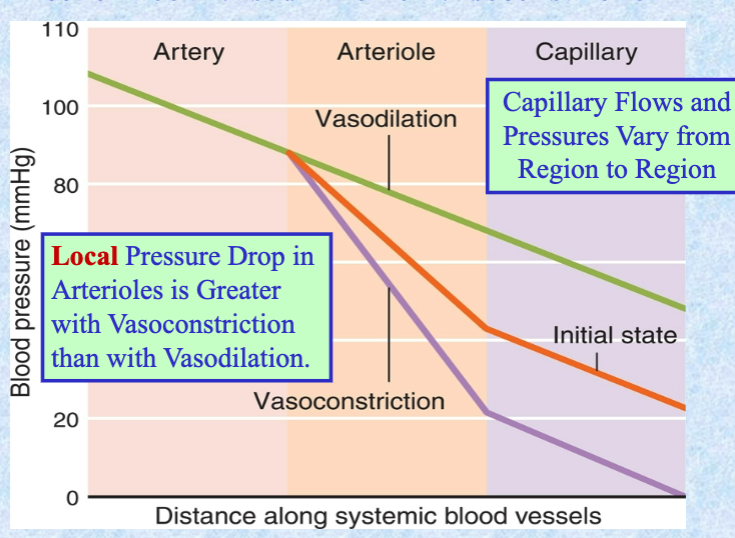
Capillary flows and pressures vary from __.
region to region
There are both __ and __ regulatory mechanisms for flow to each organ.
global; local
When cardiac output increases to match work load, flows are not __ to all organs.
uniformly increased
Coronary arteries have a dense __ on the __ surface.
capillary network; epicardial
In coronary arteries, areas of __ are subject to turbulent flow & lesions.
bifurcation
The __ provides almost a 1:1 ratio of capillaries to muscle fibers and is among the densest found in the body.
capillary network
Why are coronary arteries called “end-arteries”?
the terminations of the various coronary arteries and their branches are linked by small arterial anastomeses, but these usually are not capable of maintaining an adequate circulation if one of the major vessels is suddenly occluded
After passing through the myocardial capillaries, blood flows into a number of coronary veins, most of which are tributaries of the __, which opens into the __.
coronary sinus; right atrium
The anterior wall of the right ventricle is drained by several __, which open separately into the __.
anterior cardiac veins; right atrium
Parts of both ventricles, particularly __ regions, drain via small __ directly into the ventricles.
septal; thebesian
Between the skeletal and cardiac muscle, which has a lower density of capillaries? Why?
skeletal - bc skeletal muscle has larger average muscle fiber size vs cardiac muscle, only a fraction of capillaries are perfused in skeletal muscle unless they are at rest vs. all perfused in cardiac muscle always (heart never at rest)
consistent with the a higher blood flow of cardiac muscle than skeletal muscle under baseline conditions
When the body is resting, __ is about 4% total flow or about 200-225 ml/min
coronary flow
__ on the epicardial surface divide frequently and enter the myocardium to form a __.
large coronary arteries; dense capillary network
The majority of venous return goes to the __ via the __.
right atrium; coronary sinus
The coronary capillary circulation is embedded in the __.
contracting myocardium
When the left ventricle contracts, the pressure in the wall is __ than the perfusion pressure in the coronary vessel. This has a major impact upon distribution of __ during the cardiac cycle.
same or greater; flow & pressures
(LV feeds the coronaries)
Contractions produce substantial increases in intramural pressure and may also __ and __ vessels passing through the muscle.
deform; constrict
Passive transmission of pressure through the ventricular wall influences the __.
distribution of blood flow within the ventricular muscle
During isovolumetric ventricular contraction, coronary flow in arteries supplying the left ventricular muscle __ rapidly, occasionally to __, because of the effects of __.
decelerate; 0; extravascular compression
LVP = left ventricular pressure
LCF = left coronary flow
IC = isovolumetric contraction
IR = isovolumetric relaxation
as LVP increases, there is a sudden drop in LCF
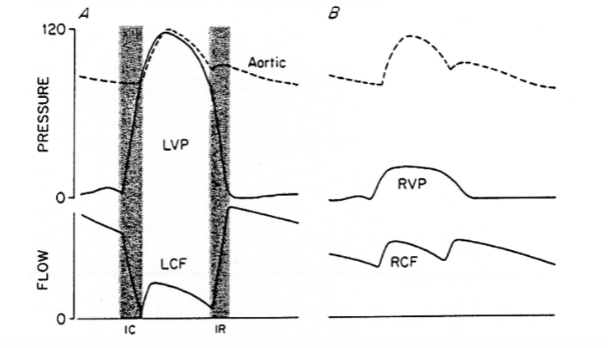
LCF increases slightly during __ phase because of rising __ pressure that increases the driving force.
early ejection; aortic
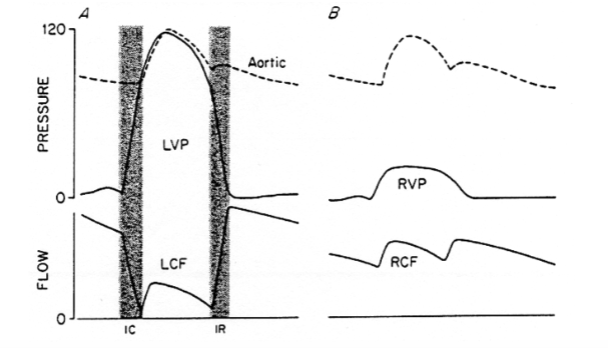
As aortic pressure falls from its peak, LCF [inc/dec] but then rapidly [inc/dec] during isovolumetric relaxation when extravascular compression is greatly [inc/dec].
dec; inc; dec
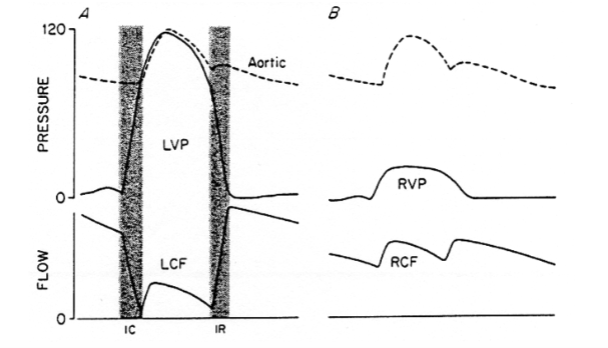
LCF [inc/dec] slowly during the remainder of diastole along the falling aortic pressure.
dec
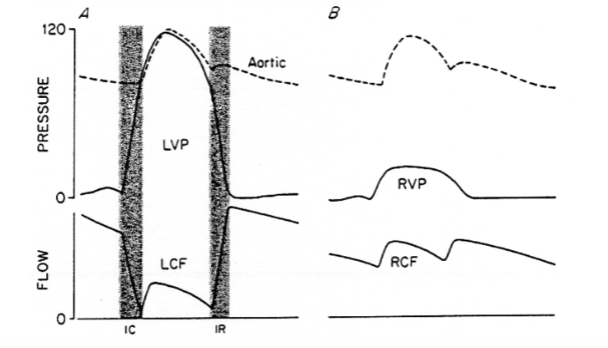
Flow in arteries supplying the right ventricle is similar to that of the left, except that __ is much higher (in right) bc:
systolic flow; RVP during systole is relatively low and a large perfusion gradient exists across right ventricular wall even during systole
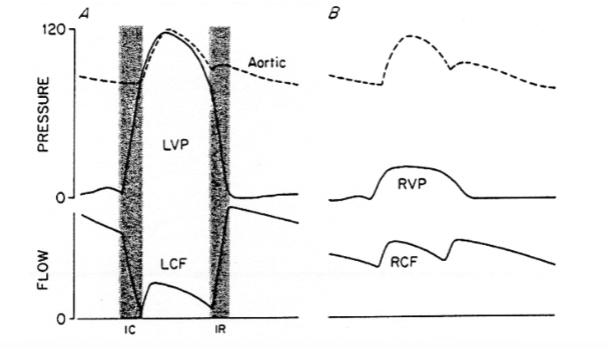
Left coronary blood flow is greatest during __.
diastole
The oxygen tension in venous blood leaving the coronary capillaries is the __ of any venous blood in the body, leaving __ room for additional O2 extraction to meet any increased demand from the heart.
lowest; little
Increased myocardial O2 demand must be met by __.
increased flow
Coronary flow is modulated primary by __ like adenosine & NO through the ANS, hypoxia, angiotensin, vasopressin, and many drugs that can also modify flow.
local metabolic factors
There is __ pressure gradient to drive blood flow through the myocardium during systole. But, the pressure difference between aortic systolic pressure and intramural ventricular pressure progressively __, from the endocardium to epicardium, so that substantial systolic flow can occur in the __ but not on the __.
no (systolic coronary arterial pressure is same as inside of left ventricular wall)
increases; outer muscle layers; inner surface
The pressure gradient across the left ventricular wall during diastole is __ and gives enough driving force for flow in __ layers. Thus, the myocardium adjacent to the left ventricular cavity receives flow only during __, whereas the outer layers receive flow __.
small; all; diastole; throughout the cardiac cycle
In the right ventricular free wall and atrial myocardium, the intracavity systolic pressures are __ relative to the coronary artery systolic pressure, so flow occurs in __.
small; all phases of the cardiac cycle
__ constrict coronary arterioles and reduce coronary flow.
angiotensin & vasopressin
__ vasodilates coronary arteries to increase blood flow
NO
The myocardial vascular bed is relatively __ and the extraction of oxygen from blood passing through it is __.
vasoconstricted; high
means that increased myocardial oxygen demands can be met only to a minor extent by increased oxygen extraction —> heart has little capacity for anaerobic metabolism
There is a strong correlation between local myocardial metabolism and __.
coronary flow
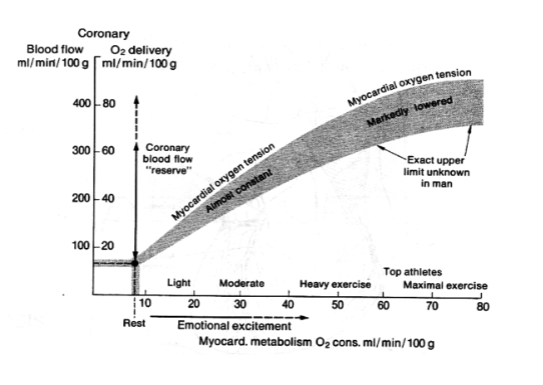
What is hyperemia?
increase in organ blood flow that occurs in response to a metabolic demand; local phenomenon not dependent on innervation or circulating hormones
Factors that increase metabolism (heart rate, force, contractility, afterload, wall tension, etc) also increase __.
coronary flow
The close relationship between metabolism and flow is supported by the fact that:
oxygen content of venous blood from resting myocardium is very low —> little additional oxygen can be obtained by increasing extraction, meaning inc oxygen demands can only be met by inc blood flow
contrasts with skeletal muscle and gut
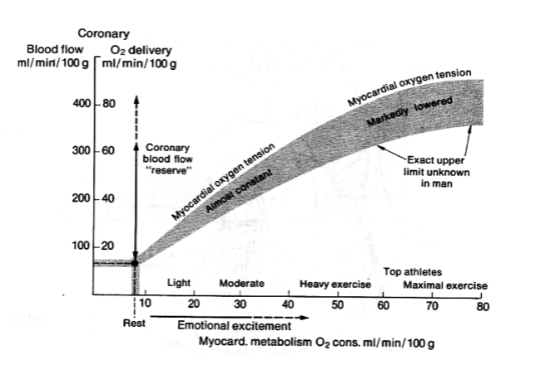
The coronary circulation is highly specialized and consists of a __ designed to adequately supply the heart with __.
dense capillary bed; oxygen
Left ventricular coronary flow is highly dependent upon __, since little perfusion is possible in the left ventricle during __.
diastolic arterial pressure; systole
Right ventricular flow is more __.
balanced
__ is relatively independent of MAP and is regulated by local hyperemia and autoregulation
cerebral blood flow
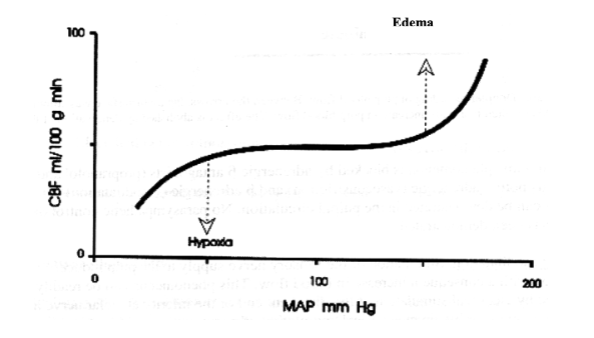
The brain consumes 20% of all O2, but there are no energy reserves within the CNS, so this rate of energy exchange can only be maintained by:
continuous supply of blood flow
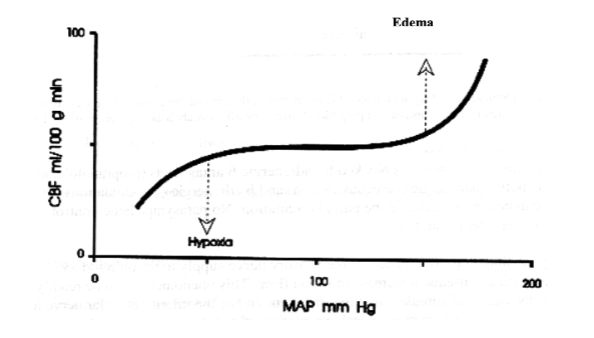
What does this graph show?
relative independence of CBF over a range of arterial blood pressure values which have been slowly altered (by hypoxia and edema)
rise in arterial blood pressure followed by rise in CBF, which over a few minutes returns to level
Cerebral neurons require an adequate supply of __ (2) at all times for the human being to remain conscious.
oxygen & glucose
Cerebral blood flow is relatively independent of __, but regulated by:
MAP; local and autoregulatory mechanisms
The changes in flow regulation via vascular resistance occur __, and do not protect the brain from:
gradually; sudden changes in MAP that can lead to a stroke
bc responses are gradually = too slow; vessels can burst from sudden pressure inc
Stimulation via the __ induces severe vasoconstriction in the vessels supplying the pulp and gingiva.
sympathetic chain
Stimulation of the __ of the glossopharyngeal nerve elicit vasodilation of the gingiva, but not the __, which doesn’t demonstrate a __ response.
parasympathetic fibers; pulp; parasympathetic
Vasodilation in the __ can be elicited by surface stimulation of the tooth or __ mediated by sensory nerve fibers that can carry signals to the brain and retrograde back inside the __.
pulp; gingiva; pulp
Irritation of the gingiva during dental procedures might increase:
blood flow to the teeth
The flow of saliva is tightly coupled to __.
blood flow
energy and fluid requirements of secretory activity require increase in blood flow (bc u secrete a lot of saliva in short time —> need inc saliva production)
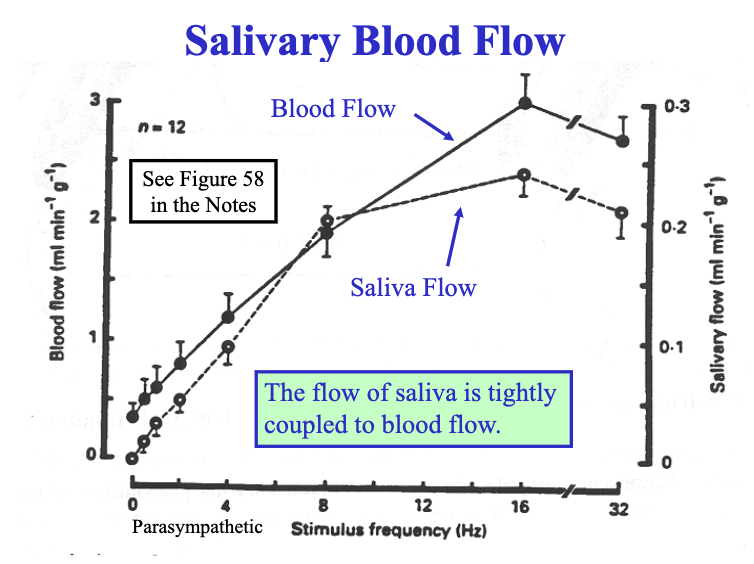
Stimulation of the __ that innervate the submandibular gland induce both secretion and an increase in blood flow.
parasympathetic fibers
sympathetic can also induce but secretary rates are lower
parasympathetic = more effective
Enzymatic secretions result from __.
sympathetic stimulation
The tooth pulp has a supply of: (3)
blood vessels
somatic sensory nerves
autonomic sympathetic nerves
Blood vessels of the dental pulp are supplied with __ innervation. When stimulated, there is a significant __ in pulpal flow via __.
sympathetic; reduction; vasoconstriction
there’s no parasympathetic control of pulpal blood flow
Blood flow to the pulp can be increased via:
retrograde stimulation of sensory (pain) nerves from external irritation of the gingiva and tooth surface
Vasodilation of pulpal vessels in the case of pain is likely caused by __, not __.
sensory nerves; ANS
In the gingiva, stimulation of sympathetic nerves can induce __. This [inc/dec] blood flow in the gingiva in spite of [inc/dec] arterial blood pressure. Local injection of adrenergic agonists also [inc/dec] blood flow by an alpha-adrenergic mechanism.
severe vasoconstriction; dec; inc; dec
Stimulation of parasympathetic control in the gingival mucosa elicits __ by a reflex mechanism which depends on __ from the CN __.
vasodilation; efferent parasympathetic fibers; 9 (glossopharyngeal)
The splachnic circulation in the viscera is an example of a __ type of circulation. There are 2 capillary beds in __.
portal; series
In the __ circulation, visceral blood flows from the capillary beds of the stomach, intestines, spleen, liver, and pancreas to the portal vein. It then flows into hepatic sinuses in the liver for __.
splanchnic; metabolic processing
In the splanchnic circulation, the __ & __ receive about 20-30% of the cardiac output at rest, which may drop to as little as 3% during __.
viscera; liver; strenuous exercise
About 20% of the __ goes through the kidneys.
cardiac output
Capillaries in the __ are highly specialized.
kidney
Highly fenestrated capillaries permit __ blood flows and __ of substances between the afferent and efferent arterioles in the glomerulus.
high; diffusion
The function of the __ circulation is to transport O2 and CO2 between the lung and circulation.
pulmonary
100% of cardiac output flows through dense capillary network surrounding the __ in the __.
alveoli; lungs
The pulmonary capillaries are __ around the alveoli to permit __.
closely packed; rapid gas exchange
__ exists whenever there is a generalized severe reduction in blood supply to the tissues.
shock
What are the 4 general categories of shock?
cardiogenic
hypovolemic shock
anaphylactic & septic shock
neurogenic shock
__ occurs whenever the cardiac pumping ability is compromised. This can be due to __ (4), which reduce cardiac output
cardiogenic shock; myocardial infarction, valvular disease, heart failure, or arrhythmias
__ occurs whenever there is a significant fluid loss. This can be due to __ (4), which lead to fluid loss.
hypovolemic shock; hemorrhage, severe burns, chronic diarrhea, prolonged vomitting
__ occurs whenever vasodilators are activated. This can be due to __ (2), which lead to decreased venous pressures and vascular resistance.
anaphylactic and septic shock; severe allergic rxns (anaphylactic) or toxins (septic) released by infectious agents
__ occurs whenever vascular tone is decreased due to a reduction in __. This can be due to: (3)
neurogenic shock; sympathetic activity; severe anesthesia, deep pain, strong emotions (mild form)
Certain emotional events can lead to a __ response.
Vasovagal
(like seeing large needle or blood)
__ tend to blunt all nerve activity, particularly the __.
anesthetics; sympathetics
In anesthetics, __ and __ tend to fall, while many vessels __. Thus, __ drops.
heart rate; contractility; vasodilate; blood pressure
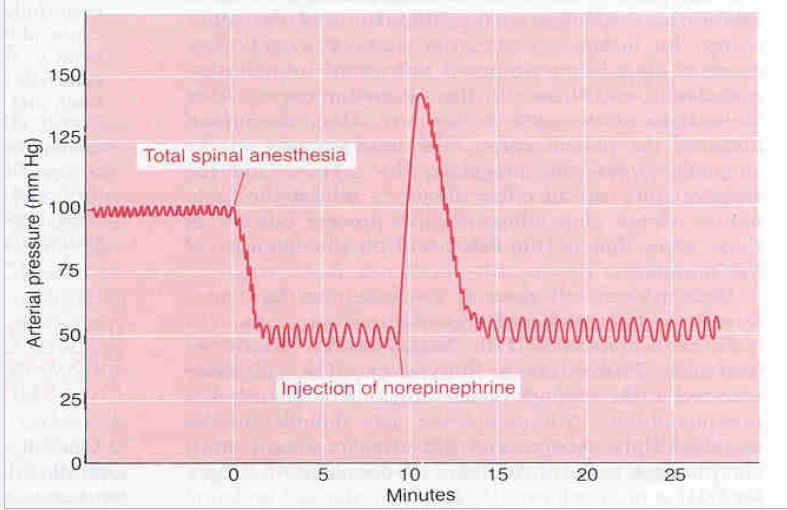
What does this graph demonstrate?
injection of spinal anesthesia decreases the arterial pressure
injection of norepinephrine increases the arterial pressure